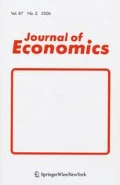Abstract
This paper examines the growth and welfare effects from an increase in the rate of money supply in an Ak type growth model with a relative wealth-enhanced social status motive, production externalities, and liquidity constraints. When only consumption is constrained by liquidity, fast money supply can hasten output growth unless seigniorage revenue is wasted and production externalities do not exist. We find that even though money growth normally promotes economic growth, it does not improve welfare when capital stock is over-accumulated. In general, an optimal monetary policy minimizes seigniorage. Our results also conclude that the optimal monetary policy rarely follows the Friedman rule.
Similar content being viewed by others
Notes
See (Walsh (2010), pp. 170–188) for a description of optimal seigniorage.
Pelloni and Waldmann (2000) point out that “waste (by useless government spending) may improve welfare,” in a modified Romer’s (1986) model with elastic labor supply. Under Romer’s technology in our paper, the useless government spending financed by seigniorage has a positive growth effect that is channeled through an increase in the agent’s social status, but it is unable to improve welfare.
Chang (2006) studies the impact of an increase in the consumption tax rate on social welfare in order to determine the optimal consumption tax policy. It appears that this is the only paper that investigates the welfare effects of government policy through a model that includes a social status-seeking motive.
See Lucas (2000) for a survey.
Even if holding money results in utilities, inflation is detrimental to real balances. Money cannot compete with capital as a way to accumulate real wealth. This feature means that the CIA constraint is always bound at equality.
The mathematical derivations of the CIA constraint on consumption and investment are available from the authors upon request.
In the case that only a fraction of investment is liquidity constrained, Chang and Tsai (2003) first point out that the growth effect of money supply is uncertain. Intuitively, there is a critical fraction of CIA on investment that balances the positive effect and the negative effect of money supply on economic growth. Readers can refer to Chen and Guo (2008) for a more generalized CIA constraint.
In the case that production exhibits capital externalities, monetary policy is always growth-enhancing. In the case that production does not exhibit externalities, monetary policy is growth-enhancing when seigniorage revenue is not wasted on useless government spending.
When seigniorage revenue is spent on useless government expenditure, Eq. (29) shows the economic growth rate is always higher than the social optimum rate, \(A-\rho \). When seigniorage revenue is lump-sum transferred to the public, Eq. (14) determines the economic growth rate as: \(\hat{\phi }=A-\rho +\beta {\upsilon }^{\prime }(1)\frac{\hat{x}}{1+\hat{z}}>A-\rho \), for all possible growth rates of money supply.
The inequality sign of Eq. (35) holds for reasonable ranges of parameters implied by empirical studies: \(0.3<\alpha <0.5\), \(0.04<A<0.1\), and \(0.01<\rho <0.04\).
References
Ahmed S, Rogers JH (2000) Inflation and the great ratios: long term evidence from the U.S. J Mone’t Econ 45:3–35
Barro RJ (1990) Government spending in a simple model of endogenous growth. J Polit Econ 98:S103–S125
Benhabib J, Spiegel MM (2009) Moderate inflation and the deflation-depression link. J Money Credit Bank 41:787–798
Chang WY (2006) Relative wealth, consumption taxation, and economic growth. J Econ 88:103–129
Chang WY, Hsieh YN, Lai CC (2000) Social status, inflation, and endogenous growth in a cash-in-advance economy. Eur J Polit Econ 16:535–545
Chang WY, Tsai HF (2003) Money, social status, and capital accumulation in a cash-in-advance model. J Money Credit Bank 35:657–661
Chen HJ, Guo JT (2009) Social status and the growth effect of money. Jpn Econ Rev 60:133–141
Chen HJ, Guo JT (2011) Money, social status and endogenous growth in a generalized cash-in-advance model. Pac Econ Rev 16:267–284
Chen SH, Guo JT (2008) On the growth and velocity effects of money. Econ Bull 5(13):1–7
Dotsey M, Sarte PD (2000) Inflation uncertainty and growth in a cash-in-advance economy. J Mone’t Econ 45:631–655
Friedman M (1969) The optimum quantity of money, and other essays. Aldine Pub. Co., Chicago, pp 1–50
Lucas RE Jr (2000) Inflation and welfare. Econometrica 68:247–274
Palivos T, Yip CK (1995) Government expenditure financing in an endogenous growth model: a comparison. J Money Credit Bank 27:1159–1178
Pelloni A, Waldmann R (2000) Can waste improve welfare. J Pub Econ 77:45–79
Rebelo ST (1991) Long-run policy analysis and long-run growth. J Polit Econ 99:500–521
Romer PM (1986) Increasing returns and long-run growth. J Polit Econ 94:1002–1037
Walsh CE (2010) Monetary theory and policy, 3rd edn. The MIT Press, Cambridge
Zou HF (1998) The spirit of capitalism, social status, money, and accumulation. J Econ 68:219–233
Author information
Authors and Affiliations
Corresponding author
Appendix A: Find the economic growth rate and nominal interest rate (R) when \(\mu ^*=0\) in the case that \(\alpha <1\) and \(\theta =0\)
Appendix A: Find the economic growth rate and nominal interest rate (R) when \(\mu ^*=0\) in the case that \(\alpha <1\) and \(\theta =0\)
In the case that \(\alpha <1\) and \(\theta =0\), the steady-state economic growth rate equals:
When \(\mu ^*=0\), (36) becomes:
where \(\hat{\phi }^0\), \(\hat{x}^0\), and \(\hat{z}^0\) respectively denote the steady-state \(\phi \), \(x\), and \(z\) under a zero rate of money growth, \(\mu ^*=0\).
From Eq. (37), we have:
By the mean value theorem, it is easy to prove that the positive root of Eq. (38) follows the relationship: \(\frac{\rho }{1+\beta {\upsilon }^{\prime }(1)}<\frac{\rho +(1-\alpha )A}{1+\beta {\upsilon }^{\prime }(1)}<\hat{z}^0<\frac{\rho }{1+\beta {\upsilon }^{\prime }(1)}+(1-\alpha )A\). Because \(\hat{\phi }^0=A-\hat{z}^0\), the inequality, \(A-\frac{\rho }{1+\beta {\upsilon }^{\prime }(1)}>\hat{\phi }^0>\alpha A-\frac{\rho }{1+\beta {\upsilon }^{\prime }(1)}\), thus holds. The nominal rate of interest, \(R^*=\alpha A+(\mu ^*-\hat{\phi }^0)=\hat{z}^0-(1-\alpha )A,\) follows to satisfy the inequality of \(\frac{\rho }{1+\beta {\upsilon }^{\prime }(1)}>R^*>\frac{\rho }{1+\beta {\upsilon }^{\prime }(1)}-(1-\alpha )A\).
Rights and permissions
About this article
Cite this article
Lee, HY., Wang, YL. & Chang, WY. Can growth-enhanced monetary policy improve welfare when people seek social status?. J Econ 110, 257–272 (2013). https://doi.org/10.1007/s00712-013-0350-8
Received:
Accepted:
Published:
Issue Date:
DOI: https://doi.org/10.1007/s00712-013-0350-8




